 |  |
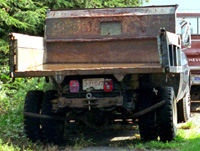 These plates are issued to commercial trucks or vehicles used for business purposes. These plates are issued to commercial trucks or vehicles used for business purposes.
While commercial truck plates were among the first types issued by most states, in Connecticut this classification did not start until 1914. By this time, Manufacturer, Dealer, Motorcycle and Livery types were already in use. Colors were the reverse of regular passenger plates. This scheme was used for 1915 and 1916 as well. For 1917 through 1921, the plates had a 'C' prefix, still with reversed colors. In 1922, the 'C' was dropped ('C' was now used on Combination plates, which were the same colors as passenger plates). In 1932, the "COMMERCIAL" legend was added, and plates were the same colors as passenger. In the following few years, some years the colors were the same as passenger, some years they were reversed.
The silver on black 1942 base was revalidated for several years with a single-digit corner tab. In 1946, a new plate with black lettering on reflectorized yellow scotchlite was introduced. The base plate was a heavy stainless steel. The 1946 tabs were made of brass, and used "stencil" numbers cut out of the tab, similar to passenger tabs. However, the prongs were reversed from the passenger tabs, so passenger tabs could not be used on non-passenger plates (well, they could, but they would be upside-down!). In 1948 a change was made to more durable white/grey scotchlite, and in 1950 the stainless steel base was left bare and shiny, still with black letters/numbers.
In 1951, a new base was issued with black letters/numbers on a silver painted background. Corner tabs were again used through 1955. Later issues of this style plate dropped the '51' from '1951', leaving '19 ' with room for the 2-digit tab to sit flush against the plate and complete the date. In 1956 the colors were reversed to silver on black. Late in this timeframe, white lettering was used on the black background. Passenger tabs were used to revalidate the plates for 1956 and 1957. |
 |
 |
1914
First year for this type |
1916
This plate was on a Stoddard-Dayton
|
| |
|
 |
|
1921
The 'C' prefix and reversed colors indicate that this is a commercial plate. Combination plates of this era also had a 'C' prefix, but were the same colors as passenger plates |
|
| |
|
 |
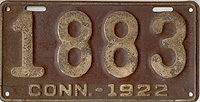 |
Another 1921
What to do after reaching C9999? Just make the plate a little longer and add another digit. Throw in a dash for good measure. This plate is 17-3/4" long - nearly a foot and a half! |
1922
The 'C' was dropped, and commercial plates were distinguished from passenger plates by the reversed colors through 1931 |
| |
|
 |
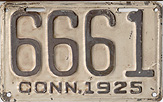 |
1923
This plate was completely rust-stained when I got it, but it cleaned up very nicely. |
1925 |
| |
|
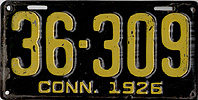 |
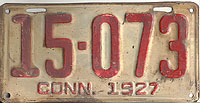 |
| 1926 |
1927 |
| |
|
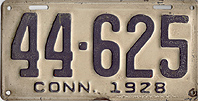 |
 |
| 1928 |
1929 |
| |
|
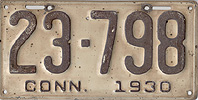 |
 |
| 1930 |
1931 |
| |
|
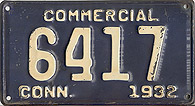 |
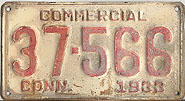 |
1932
In 1932, the 'Commercial' caption was added to these plates |
1933
This plate was likely used on a cement truck- has a nice coating on the front! |
| |
|
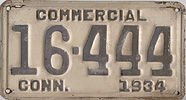 |

|
| 1934 |
1936 |
| |
|
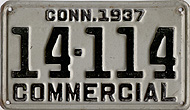 |
 |
| 1937 |
1939 |
| |
|
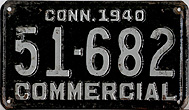 |
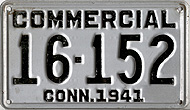
|
| 1940 |
1941 |
| |
|
 |
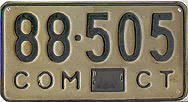 |
1946/47 issue used until 1950.
The yellow scotchlite on these plates didn't hold up too well. |
Late 1940s
This scotchlite on this one held up very well, but only because the plate was never used! |
| |
|
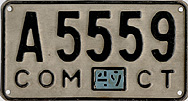 |
 |
1949, with more durable white scotchlite background.
After 99-999 a letter prefix was used. |
1950 |
| |
|
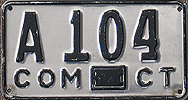 |
 |
| 1950, bare stainless base. I'm not sure why there is an A-series plate with 3 numbers on the bare stainless base, since it would have been issued after the 4-digit A series on the scotchlite base. |
1950 issue with bare stainless steel background.
Most of the plates pictured on this site were scanned in, but the background on this plate is so shiny that the scanner couldn't handle it! |
| |
|
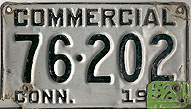 |
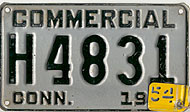 |
1952
From 1951 to 1955, corner tabs were
used to indicate the year. Some issues had '1951' stamped in the corner, while later ones only had '19 ', with the tab indicating the year. |
1954
This plate is an example of one with the '19 ' date |
| |
|
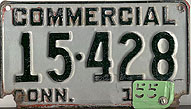 |
 |
| 1955 |
1956 |
| |
|
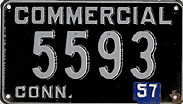 |

|
| 1957 |
Late 1957 issue, with white numbers/letters instead of silver. |
| |
|
|
|
|
